A spider taking a poop is not something that you normally see. Do spiders actually poop? Could they be responsible for some of the stains you see on walls or window sills around the house?
Yes, spiders do poop. Everything that eats excretes. Spiders actually don’t pee, therefore spider poop consists of waste materials (guanine), semisolid uric acid (found in pee), and the remains of ingested insects. Spider poop isn’t solid it’s a thick liquid, white, gray, brown, or black in color.
While the fact that spiders poop should not come as much of a surprise, the way they do this raises it up to a new level of grossness.
Read on to find out more about the digestive system of the infamous arachnid.
What Is Spider Poop?
Close to the abdominal surface of many spiders, one can notice bright white colors which are a result of the accumulation of spiders’ excretory material. You can observe this in the harmless common garden spider.
This waste matter is called guanine and it is concentrated in a band of continuous cells that lie beneath the surface of the spider’s abdomen. The spider’s abdomen is covered with a transparent cuticle. The cells in the abdomen reflect light passing through the cuticle.
Guanine is a white amorphous solid and is insoluble in water. The name derives from the Spanish loanword guano, meaning” bat/bird droppings”. Guano forms a significantly abundant constituent in the excrement of birds.
Guanine has part nitrogen, oxygen, carbon, and hydrogen in its chemical structure. This organic compound belongs to the purine group. It makes up the spider poop that collects in the stercoral pocket before it is excreted.
Do Spiders Pee?
Spiders, scorpions, and some amphibians do not pass liquid urine the same as mammals. Spiders have Malpighian tubes that absorb essential minerals and salts and balance water retention (osmoregulation).
They function as kidneys by collecting waste from the digestive tubule. Spiders convert this waste into ammonia, which is a product of protein metabolism in the cells. It’s then converted into guanine, as it can be excreted with minimum water loss.
Purine is a colorless crystalline compound with basic properties forming uric acid on oxidation. Adenine and guanine are examples of purines.
Purines are also found in meat and meat products. They are broken down to form uric acid, which is passed in urine in animals. In spiders, the uric acid forms part of poop and is expelled with fecal matter.
What Color Is Spider Poop?
Spider droppings are a combination of digested food (insects) and waste products as we saw earlier. They don’t leave solid droppings; instead, their droppings are thick and liquid in a pin head-size in various shades of white, gray, brown, or black.
Usually, the poop is accompanied by a bolus-a tiny ball consisting of the remains of the prey. Fresh poop appears as a thick and white liquid with black stains. When it dries the color can change to grey, light brown, or black.
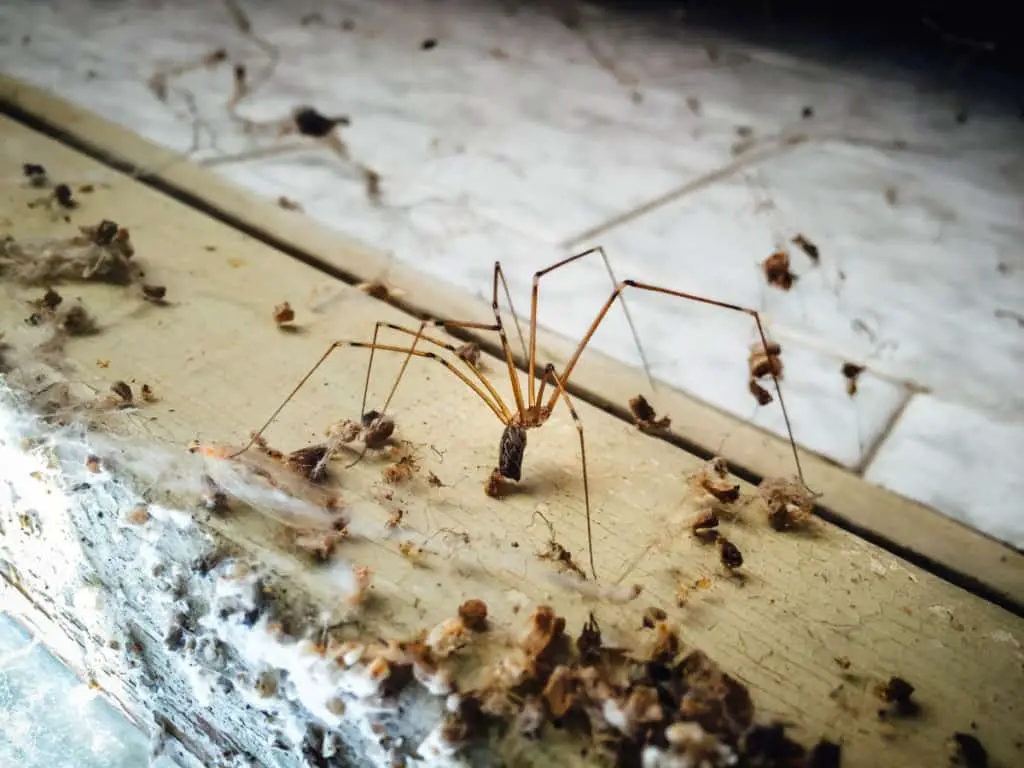
The color and appearance of the poop vary depending on the species. Size also varies from species to species. Large species like tarantula will defecate large amounts of poop.
Is Spider Poop Toxic?
Among the many species of insects consumed by spiders, are filth flies which include the house fly and bottle flies, these associated with over 100 disease-causing pathogens. The most common of these pathogens include;
· Salmonella spp
· Enterococcus spp
· Staphylococcus spp
· Streptococcus spp
However, there is little evidence to show that spider droppings contain some of these disease-causing pathogens. It is thought by researchers that the possible explanation of the absence of pathogens in spider poop is the antimicrobial properties found in spider venom.
Remember that spiders subdue their prey by injecting venom into their victims. However, it is not clear whether poop from species (other than black widow spider) will be free from bacteria.
Some studies have shown that some spiders have antibacterial properties in their venom and blood which may further explain the lack of bacteria.
Where In Your House Are You Likely To Find Spider Poop?
Spider poop can be found on any surface frequently visited by spiders. Spiders prefer to make their webs in areas with the least disturbance by human traffic such as corners of the house that are dark and provide cover for them during the day.
You are also likely to find spider poop around lights in the home as spiders are attracted to lights, not because of the light but because other bugs are attracted to lights. The lights bring their prey directly to them. It is the spider equivalent of room service.
Other places where you will find spiders and therefore their droppings are in garages, cabinets, ceilings, and barns pretty much any space with a source of food and cover from would-be predators.
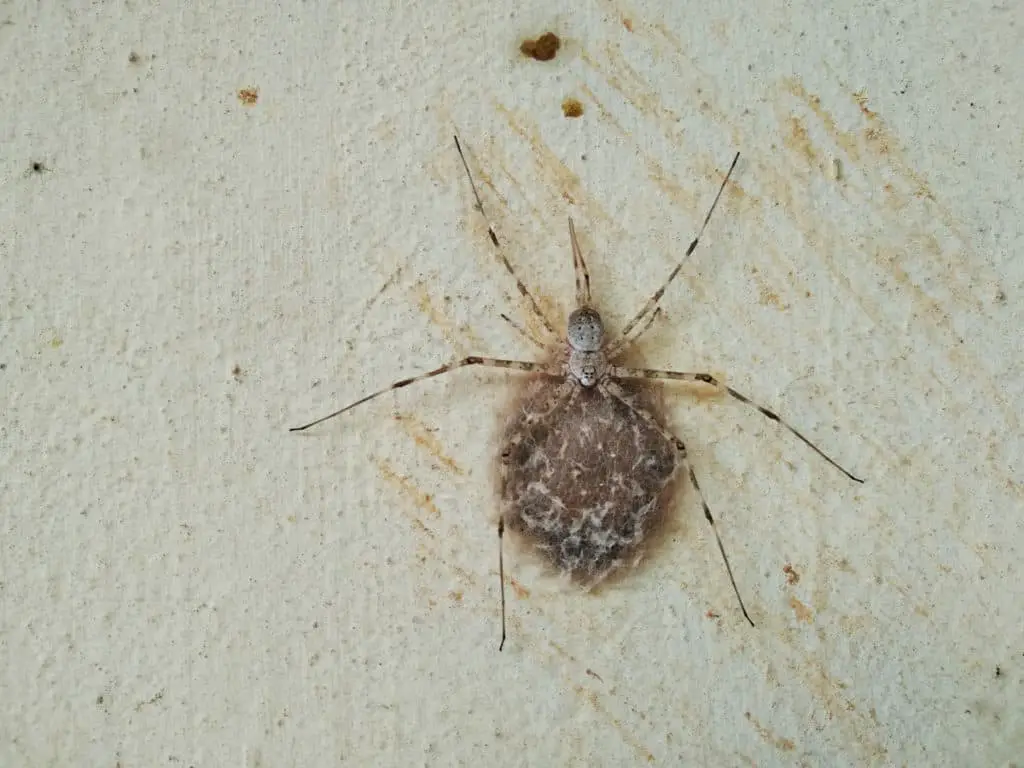
How To Clean Up Spider’s Poop Around The House
You can use an inexpensive and common household item to thoroughly clean the exterior of your house and remove spider droppings. The simple steps to achieve a good outcome are:
1. Rinse the surface dust and debris off with a water hose
2. Fill a bucket with one gallon of cool water and pour one cup of oxygen bleach into the water. Use a long-handled spoon to stir until the oxygen bleach dissolves. You can also use chlorine bleach instead of oxygen bleach. However, oxygen bleach is a safer alternative to chlorine bleach since it will not harm vegetation or discolor clothing.
3. Using a scrub brush with an extension handle, begin scrubbing the spider droppings off the surface. Make sure you first dampen the scrub brush in the bleach mixture. Alternatively, saturate the surface with the mixture using a pump sprayer before scrubbing with a scrub brush.
4. Leave the mixture on the exterior of the surface for 10 minutes. Rinse the siding clean with a water hose. Repeat the processes until you have removed all spider droppings from your house; they can be quite stubborn and may require a little more effort. But you can easily dislodge dried droppings on smooth surfaces with the help of a chisel or any other hard-edged tool, and then follow up by cleaning.
5. Household cleaning agents may contain chemical solvents that can damage furniture surfaces or finishing and coatings. It is advisable to use them with caution or get expert advice from pest control technicians. Also, take precautions if you are using these products when cleaning pet cages.
How Do Spiders Capture, Eat And, Digest Their Prey?
To know a little bit more about the digestive system of the crawling insect, we need to dive briefly into the details of how spiders capture their prey. This will give us a good insight into how these creatures eat and then digest their food.
How Do Spiders Capture Prey?
There are two general groups of spiders:
- The wandering or hunting spiders
- The web-building spiders.
Both are similar in anatomy because they are all arachnids with two stigmata (segments).
Spiders have the following basic external characteristics:
- Eight legs;
- Bodies divided into two segments, rather than the three found in insects;
- No wings;
- No antennae;
- Multiple simple eyes, rather than the compound eyes seen in insects
Spiders belong to a unique class of arachnids and are distinguished by the following;
- Production of silk
- The ability to produce venom in most species
- Specialized pedipalps used in mating
Read on to know how the two groups mentioned above, web building and wandering spiders, fare in terms of capturing their prey.
1. Wandering Spiders
Wandering or hunting spiders also can create silk which they usually use as draglines; wrapping eggs or creating tunnels. With impeccable eyesight due to their many eyes and two large ones, and have good eyesight, the wandering crawlers search and hunt for prey. Their legs are thicker and more powerful for chasing and jumping on prey.
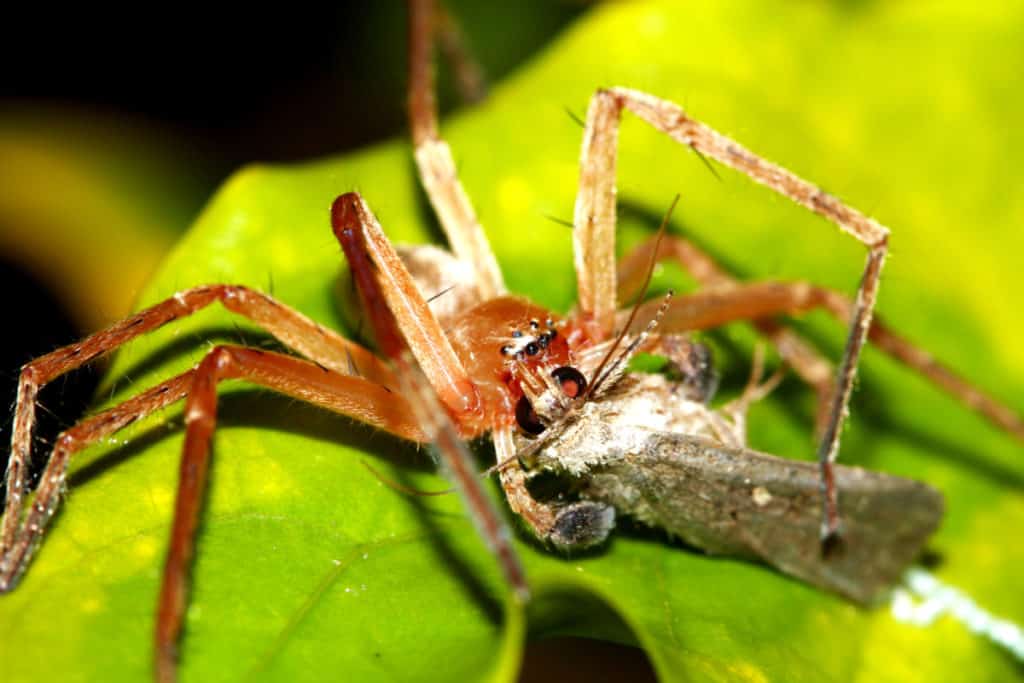
Wandering spiders have powerful serrated fangs that are arranged up and down. Their hairy legs have airy pads for traction and web walking; their modified feet allow them to climb walls, run quickly, and jump on prey.
Jumping spiders are part of this group of spiders. We have written an article about the diet of jumping spiders if you are interested, What Do Jumping Spiders Eat?
2. Web Building Spiders
Even though web-building spiders have many eyes, they are all tiny, leading to the poor eyesight of the insect. Their thin legs are hairy with three hooks hanging on web strands.
The web-building spider usually waits for the prey to get stuck on the web. Web-building spiders are agile and patient; they don’t rely on eyesight to find their prey. Instead, they sense the vibrations produced by the silky spinnerets as trapped prey try to struggle free. The spider then moves in with dead accuracy to start feasting on the catch.
They have weak jaws with fangs more horizontal and are not always serrated. The different characteristics we have highlighted above determine how these two groups of spiders subdue and consume their prey.
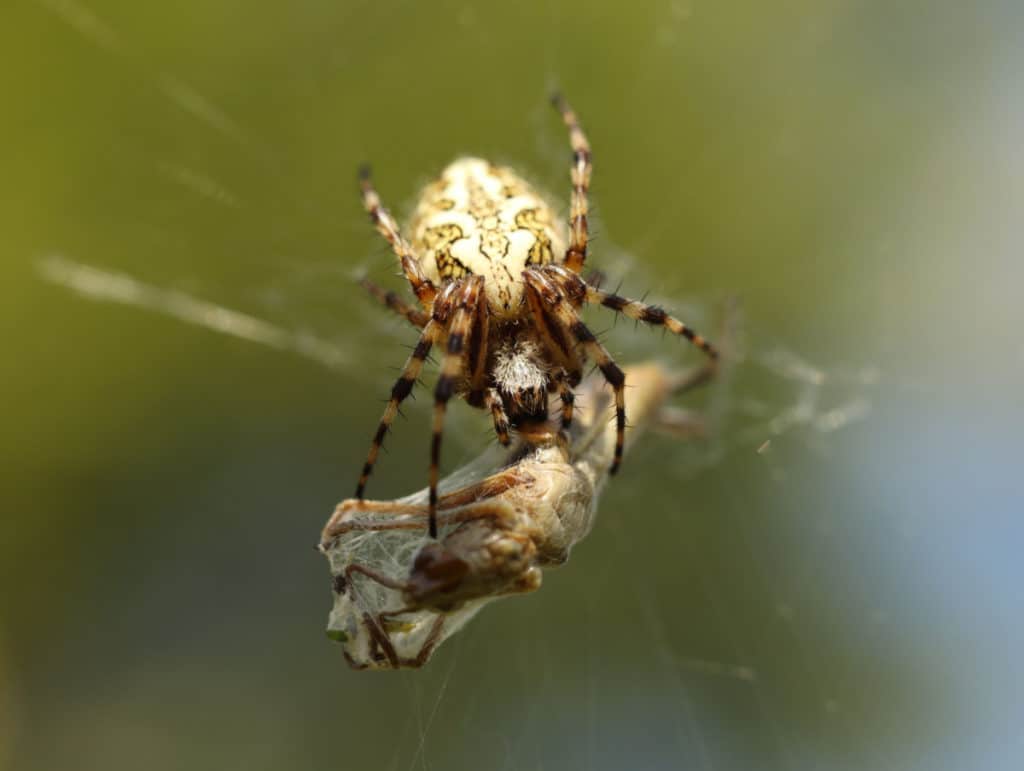
Let’s keep in mind that spiders don’t have true teeth, instead, they have fangs that inject venom. Venom is delivered through their hollow pointed fangs on the ends.
Most spider venom is specifically made to be toxic to Arthropods which consists of other insects and spiders. These make up the majority of spiders’ prey.
If you are interested we have an entire article on the diets of spiders. Would you believe there is a species that can even eat birds? The article is called, What Do Spiders Eat?
How Do Spiders Eat Their Prey?
Spiders can’t chew and can only suck or drink semisolid, mashed food. To tenderize the prey, the insect uses its chelicerae (mouthparts). The chelicerae may be shaped as either articulated fangs or can function as pincers.
In nearly all spider species they are hollow and contain venom. They are connected to venom glands and are used to inject venom into prey or a perceived threat. These are the only appendages that are in front of the mouth and are used to capture prey.
The wandering spiders usually require a firm surface on which to hold and masticate their prey.
Most spider species partially digest their prey as it is held in the chelicerae. But not all spiders have strong enough chelicerae to hold and tear apart their prey. They spew digestive enzymes onto the food, starting the digestion process outside the body.
After capturing the prey, spiders expel digestive enzymes from their intestinal tract (digestive gland) onto the victim. The enzymes break down its body tissues within a few seconds, resulting in predigested liquid tissues. The spider then sucks up the predigested liquid food and repeats this process many times, ending up ingesting the entire prey.
How Does A Spiders Digestive System Work?
The spider’s stomach and brain are combined into the body segment called Cephalothorax. (Cephalon means head/brain). The spider’s legs, chelicerae, eyes, mandibles, claws, and pedipalps are all attached to the cephalothorax, which is the front body (prosoma).
The abdomen is connected to the front body by a thin waist-like structure called the pedicel. This body segment (opisthosoma) contains the gut, heart, reproductive organs, and silk glands.
Let’s look now at the digestive anatomy of the spider and how it works. Apart from the chelicerae and their functions, other parts of spiders’ digestive anatomy include:
- Pharynx
- Esophagus
- sucking stomach
- Digestive gland(cecum)
- Intestine
- Digestive tubule
- Malpighian tubules
- Stercoral pocket
- Anus
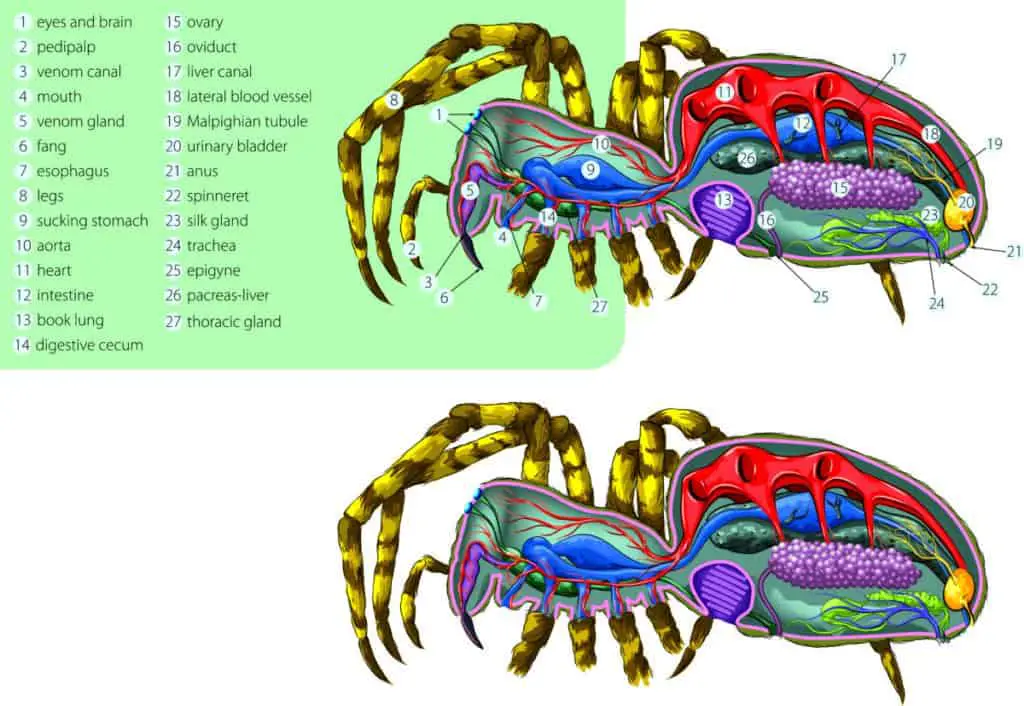
So what happens at each stage of the digestive system? Reading on you will find out there are three stages of the digestion process in spiders. These are:
- External Digestion
- Internal Digestion
- The Midgut
1. External Digestion
Food is digested externally (pre orally) by way of covering prey with digestive juices secreted from a series of ducts perforating the chelicerae. Some spiders macerate their food using their serrated chelicerae as they cover it with digestive enzymes secreted by the digestive tract.
Others bite the prey and pump digestive juices into it which break down the internal tissues into a liquefied form.
2. Internal Digestion
The spider then proceeds to suck the liquefied prey through its mouth by use of the sucking stomach. The sucking stomach is situated in the cephalothorax. This organ is a muscular pump with valves to ensure the one-way movement of the mashed food.
The food passes through the narrow pharynx (throat), into the esophagus, and into the sucking stomach, which is part of the midgut.
3. The Midgut
The midgut has a variable number of blind extensions or ceca-usually four pairs which extend in the first segments of the legs (coxae). The intestine extends into the digestive tubule where internal digestion and nutrient absorption take place.
Additional ceca and a branched digestive gland are located at the front of the abdomen. The main functions of the ceca are to absorb fluids and salts. Attached to the digestive tubule are the malpighian tubules which are equivalents to kidneys.
At the end of the gut, a cecum (stercoral pocket) is located and it connects with the hindgut before ending through the anus. The stercoral pocket is a pouched diverticulum that serves as a reservoir for fecal material (spider poop). Spiders expel poop through the anal opening.
We now know that spiders process their food through digestion and produce poop as part of their wastes.
The Wrap Up
Spiders do play an important role in the ecology by preying on mites, fleas, flies, and other harmful insects and pests. They help to keep these insects in check by naturally controlling their populations. But the fear of spiders by many people overshadows these beneficial roles.
They can be found in diverse environments and habitats on all the continents of the world. To a large extent, spiders eat insects and other arthropods like caterpillars, centipedes, and millipedes.
Wandering spiders hunt and pursue their prey. Web-building spiders spin webs to trap their prey. Spiders predigest their food outside of their bodies by spewing digestive enzymes onto their prey. Digestion takes place externally and internally.
Spider’s excrement is called guanine and consists of uric acid and wastes from the remains of ingested insects from the spider’s diet.
If you found this article about spider poop interesting then maybe you would also find these other articles we have written about poop interesting:
- Do Carpet Beetles Poop And What Does It Look Like?
- Do Ladybugs Poop?
- Do Bees Poop? You Won’t Believe How Long They Can Hold It.
- Is Honey Bee Poop? But It’s So Tasty
Sources
https://en.wikipedia.org/wiki/Spider_anatomy
https://kids.britannica.com/students/article/spider/277177
https://study.com/academy/lesson/arachnid-digestive-system-diet.html
https://www.sciencedirect.com/science/article/abs/pii/0010406X66901368
